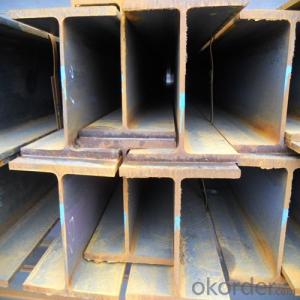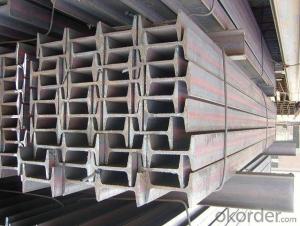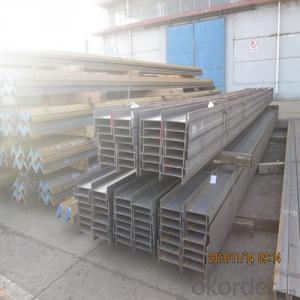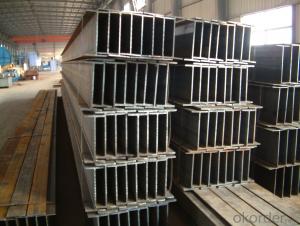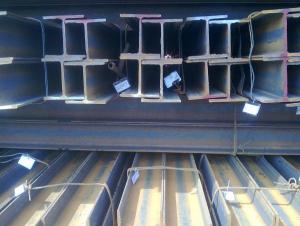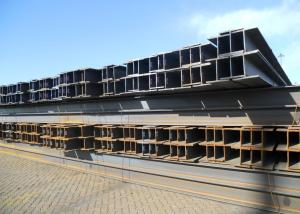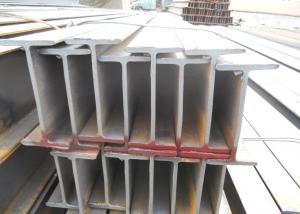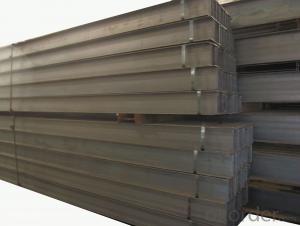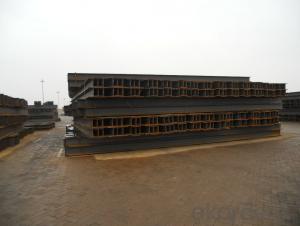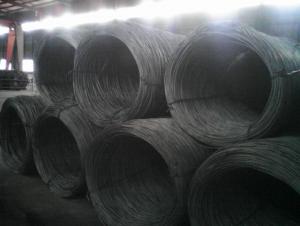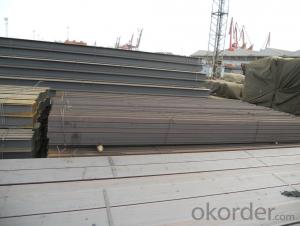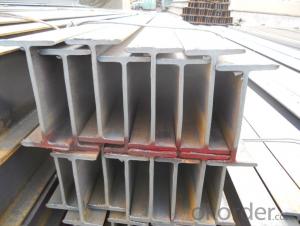Hot Rolled H-Beam Steel
- Loading Port:
- China Main Port
- Payment Terms:
- TT or L/C
- Min Order Qty:
- 50 Tons m.t.
- Supply Capability:
- 1000 Tons Per Day m.t./month
OKorder Service Pledge
OKorder Financial Service
You Might Also Like
Specifications of Hot Rolled H-Beam Steel
1. Standard: JIS G3101
2. Grade: SS400 or Equivalent
3. Length: 6m,10m, 12m as following table
4. Invoicing on theoretical weight or actual weight as customer request
5.Payment: TT or L/C
6. Sizes:
SIZE(mm) | DIMENSION(kg/m) |
100*100 | 16.9 |
125*125 | 23.6 |
150*75 | 14 |
150*150 | 31.1 |
148*100 | 20.7 |
198*99 | 17.8 |
200*100 | 20.9 |
248*124 | 25.1 |
250*125 | 29 |
300*150 | 36.7 |
298*149 | 32 |
200*200 | 49.9 |
294*200 | 55.8 |
346*174 | 41.2 |
350*175 | 49.4 |
244*175 | 43.6 |
175*175 | 40.4 |
294*200 | 55.8 |
298*201 | 64.4 |
346*174 | 41.2 |
350*175 | 49.4 |
400*200 | 65.4 |
396*199 | 56.1 |
450*200 | 74.9 |
446*199 | 65.1 |
340*250 | 78.1 |
500*200 | 88.1 |
300*150 | 36.7 |
Usage & Applications of Hot Rolled H-Beam Steel
Commercial building structure ;Pre-engineered buildings; Machinery support structure; Prefabricated structure; Medium scale bridges; Ship-building structure. etc.
Packaging & Delivery of Hot Rolled H-Beam Steel
1. Packing: it is nude packed in bundles by steel wire rod
2. Bundle weight: not more than 3.5MT for bulk vessel; less than 3 MT for container load
3. Marks:
Color marking: There will be color marking on both end of the bundle for the cargo delivered by bulk vessel. That makes it easily to distinguish at the destination port.
Tag mark: there will be tag mark tied up on the bundles. The information usually including supplier logo and name, product name, made in China, shipping marks and other information request by the customer.
If loading by container the marking is not needed, but we will prepare it as customer request.
4. Transportation: the goods are delivered by truck from mill to loading port, the maximum quantity can be loaded is around 40MTs by each truck. If the order quantity cannot reach the full truck loaded, the transportation cost per ton will be little higher than full load.
5. Delivered by container or bulk vessel
Production flow of Hot Rolled H-Beam Steel
Material prepare (billet) —heat up—rough rolling—precision rolling—cooling—packing—storage and transportation

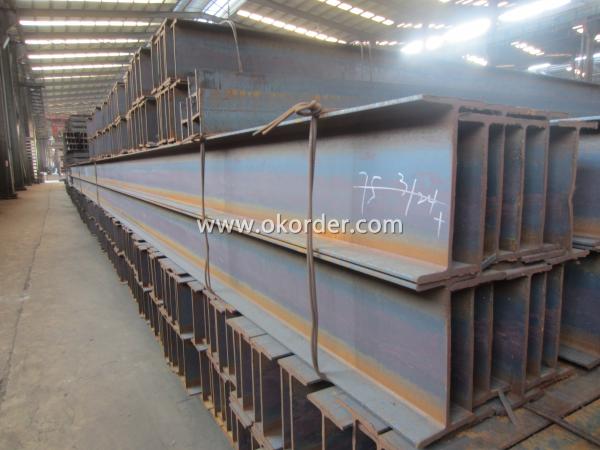
- Q: Can steel H-beams be used for supporting sports stadium roofs?
- Yes, steel H-beams can definitely be used for supporting sports stadium roofs. Steel H-beams are commonly used in construction due to their high strength and durability. They have the ability to bear heavy loads and provide structural stability. In the case of sports stadium roofs, where large spans and open spaces are required, steel H-beams are an ideal choice as they can span long distances without the need for intermediate supports. Additionally, steel H-beams can be fabricated and welded together to create complex roof structures, allowing for flexible and innovative design options. Overall, the use of steel H-beams for supporting sports stadium roofs ensures safety, longevity, and cost-effectiveness.
- Q: Can steel H-beams be used in telecommunications towers?
- Yes, steel H-beams can be used in telecommunications towers. They are commonly used due to their high strength and superior load-bearing capabilities, making them suitable for supporting the heavy equipment and antennas required in telecommunications infrastructure.
- Q: Can steel H-beams be welded?
- Yes, steel H-beams can be welded. H-beams are commonly made from structural steel, which is known for its weldability. Welding is a widely used method to join two or more steel beams together in various construction and fabrication applications. However, it is important to follow proper welding procedures and techniques to ensure a strong and reliable weld. This may involve preheating the beams, selecting the appropriate welding process (such as arc welding or gas metal arc welding), and using the correct welding consumables. Additionally, it is important to ensure that the weld is done by a skilled and certified welder to guarantee the structural integrity of the H-beams.
- Q: Can steel H-beams be used in educational institutions and schools?
- Certainly, educational institutions and schools can utilize steel H-beams. These beams are frequently employed in construction due to their robustness, longevity, and ability to bear heavy loads. They find widespread application in the building of bridges, high-rise structures, and other large edifices. Within educational institutions and schools, steel H-beams offer a multitude of possibilities. They can serve as support for building frameworks, facilitate the construction of gymnasiums and auditoriums, enable the creation of outdoor structures such as canopies or walkways, and even be utilized for educational purposes in engineering or construction-related courses. By implementing steel H-beams, educational institutions guarantee the safety and stability of their structures, thus creating an optimal environment for learning and various activities.
- Q: What is a steel H-beam?
- A steel H-beam, which is also referred to as H-section or I-section, is a type of structural beam that is made out of steel and has a shape that resembles the letter "H". This beam is extensively utilized in construction and civil engineering projects because of its remarkable strength and versatility. The primary purpose of the H-beam is to evenly distribute the weight or load across its horizontal flanges, which are connected by a vertical web. This particular design offers exceptional load-bearing capabilities and enables structures to have longer spans and enhanced stability. H-beams are commonly employed in buildings, bridges, highways, and other infrastructure projects to provide support for heavy loads and resist bending or twisting forces. The manufacturing process of the steel H-beam involves either hot rolling or welding, and it can be obtained in various sizes and dimensions to suit different applications.
- Q: What are the considerations when designing for thermal bridging in Steel H-Beams?
- When designing for thermal bridging in steel H-beams, there are several considerations that need to be taken into account. Firstly, it is important to understand that steel is a highly conductive material, meaning it conducts heat more effectively compared to other building materials such as wood or insulation. This makes steel H-beams prone to thermal bridging, which is the transfer of heat across a solid structure, resulting in heat loss or gain. To mitigate thermal bridging in steel H-beams, one consideration is to provide a thermal break. This involves incorporating a layer of insulation between the steel beam and the surrounding components. The insulation acts as a barrier, preventing the transfer of heat and reducing thermal bridging. Various materials can be used for thermal breaks, such as rigid foam insulation or specially designed insulating materials. Another consideration is the overall design of the building envelope. By optimizing the insulation levels and minimizing the number of steel H-beams in areas of high thermal importance, the potential for thermal bridging can be reduced. Proper placement and sizing of insulation around the beams can also help in minimizing heat transfer. In addition, careful detailing and construction practices are crucial when designing for thermal bridging in steel H-beams. It is important to ensure that the insulation is installed properly and fully covers the steel beams, leaving no gaps or voids that could compromise the thermal performance. Proper sealing and weatherproofing of the building envelope is also essential to prevent air leakage, which can exacerbate thermal bridging. Lastly, it is important to consider the long-term durability and maintenance of the thermal solution. The chosen insulation materials should be durable, resistant to moisture, and able to withstand the potential stresses and movements of the steel beams. Regular inspections and maintenance should be carried out to ensure that the insulation remains intact and in good condition. Overall, by considering the thermal properties of steel H-beams and implementing appropriate design strategies, it is possible to minimize thermal bridging and improve the energy efficiency of a building.
- Q: Can steel H-beams be used for bridge construction?
- Indeed, steel H-beams are applicable for bridge construction purposes. Known interchangeably as I-beams or W-beams, these steel H-beams are frequently employed in bridge construction due to their remarkable strength and capacity to bear loads. Offering exceptional structural support, H-beams are capable of enduring substantial weights, rendering them well-suited for bridges necessitating support for both vehicular and pedestrian traffic. Furthermore, steel H-beams possess durability, resistance to corrosion, and effortless fabrication and installation, thereby solidifying their status as a favored option in bridge construction ventures.
- Q: Can steel H-beams be used in seismic zones?
- Yes, steel H-beams can be used in seismic zones. Steel has high strength and ductility, making it suitable for withstanding seismic forces. Additionally, H-beams are designed to distribute loads and resist bending, making them a commonly used structural element in seismic-resistant construction. However, it is important to ensure that the design and installation of H-beams in seismic zones comply with local building codes and regulations to ensure the safety and stability of the structure.
- Q: What does "H400*250*8*12" mean in steel structures?
- Total domestic steel structure (special) level of construction enterprises 143, an increase of 427 qualification for steel structure, with a qualification for steel structure enterprises amounted to 570! Recently, Shanghai Metal Structure Association statistics data show that in the city of Shanghai Metal Structure Industry Association member units, steel fabrication and installation of enterprises (including some provinces and municipalities) a total of 380, the annual output of 3 million 600 thousand tons, and it is said that only the Shanghai area registered steel construction enterprises reached five hundred or six hundred. The development of steel structure industry, like China history the Warring States period, the steel structure enterprises from dozens to thousands, but with an annual output of 100 thousand tons of enterprises is very small, the formation of the rapid development of the market, and industry concentration is more and more low contrast. The reason is the main steel structure industry low barriers to entry, whether it is money or technical requirements are not too high.
- Q: Can steel H-beams be used in residential deck or patio structures?
- Indeed, residential deck or patio structures can indeed utilize steel H-beams. The construction industry often favors steel H-beams due to their robustness and endurance. These beams can offer crucial support to decks and patios, particularly in regions where substantial loads or extended spans may be present. Steel H-beams possess resistance against warping, twisting, and shrinking, rendering them apt for outdoor structures that face diverse weather conditions. Moreover, steel H-beams can be readily tailored to meet precise design specifications, thus guaranteeing a secure and dependable residential deck or patio structure.
1. Manufacturer Overview
| Location | Tangshan, China |
| Year Established | 2007 |
| Annual Output Value | Above US$ 80 Million |
| Main Markets | Mid East; Southeast aisa; korea |
| Company Certifications |
2. Manufacturer Certificates
| a) Certification Name | |
| Range | |
| Reference | |
| Validity Period |
3. Manufacturer Capability
| a) Trade Capacity | |
| Nearest Port | Tianjin; |
| Export Percentage | 20% - 25% |
| No.of Employees in Trade Department | 11-15 People |
| Language Spoken: | English; Chinese |
| b) Factory Information | |
| Factory Size: | Above 75,000 square meters |
| No. of Production Lines | 1 |
| Contract Manufacturing | OEM Service Offered; |
| Product Price Range | Average |
Send your message to us
Hot Rolled H-Beam Steel
- Loading Port:
- China Main Port
- Payment Terms:
- TT or L/C
- Min Order Qty:
- 50 Tons m.t.
- Supply Capability:
- 1000 Tons Per Day m.t./month
OKorder Service Pledge
OKorder Financial Service
Similar products
Hot products
Hot Searches
Related keywords












